Proposal
Our final assignment aims to explore the relationship between sight and sound. Sight and sound in a film is a fundamental of storytelling. It evokes emotions, enhances the narrative, and creates a more immersive experience for the audience. The limitations of this project can fuel creativity and lead to innovative outcomes and new approaches to filmmaking. I hope to use this final assignment as well as the practice activities as catalysts for my artistic growth and exploration—like in The Five Obstructions. Furthermore, as a filmmaker during the next few projects, it is important to note the uncertainty of documentarism proposed by Hito Steyerl. One must note that documentary forms can “create false intimacy and even false presence.” Do we want this falsity? Do we value expression or representation? It is in the agency of the artist to choose whether they want to create an unfiltered truth or a synthesized fiction. Furthermore, can expression not be a form of representation? I intend to see how fiction, visual metaphors, can inform the truth through synthesized means.
3-in-1 Exercise
Introduction
I was assigned to record a continuous 30-second video with a clearly defined beginning, middle, and end. Through this exercise, I intend to explore the importance of structure in filmmaking as well as familiarize myself with filming equipment and techniques.
Concept
The following shows the structure of the video:
Beginning—A dark world that represents our dreams and subconscious mind. The mood is eerie.
Middle—The woman appears and starts singing “Nature Boy” by Nat King Cole.
End—The end is signified by the last chime of the music box in the woman’s hand.
The panning of the performance is aimed to introduce a sense of disorientation, mystery, and playfulness. Furthermore, the sudden dimming of lights at the end aimed to evoke a sense of ominousness for the viewers. Additionally, the setting is peculiar and eerie due to the spotlight that makes everything around it dark. Thus, I believe that the combination of all these factors created a compelling 30-second video that has concept, originality, composition, and aesthetic.
The woman manually winds a music box while chanting “Nature Boy” in a seductive yet ominous way. The viewers are enticed to listen to her stories and nostalgia.
Additional notes: Although the subject matter, the performer and her performance, was not originally prepared by me, I believe that through this exercise I was able to learn a lot about cinematography and film techniques and explore the relationship between sight and sound. My exercise is less about the content and more about how structure and technique can create a compelling narrative. Furthermore, our class also studied The Uncertainty of Documentarism by Hito Steyerl where we explored the intricate relationship between truth and fiction in the context of the documentary form. Through this exercise of documenting performance, I came to understand this connection more.
Process
The video was taken in the McKinnon Hotel at West Beijing Road. The setting allowed the conditions to create a more professional video: spotlight, professional performance, professional “actors” and no background noise.
Adaptation Mapping
One of the challenges was to get the equipment I needed for this assignment as a lot of classmates required the same equipment as me. Thus, I resorted to using my phone. I also used the table and my bag as a stabilizer and panner. Another challenge was ensuring the video quality. Even though I had selected the 4k resolution on my phone, there was a possibility that the dark environment lowered the video quality. However, I believe the distance helps to compensate for the compromised quality.
On the other hand, I was very happy with the final result as it had a good beginning, middle, and end as well as composition and aesthetic.
Conclusion
Filming a clearly defined beginning, middle, and end can teach us valuable skills. Firstly, it highlights the importance of structure in storytelling. Through a well-structured narrative, we can engage the audience and effectively convey our message or story. It helps us present a video logically and legibly which allows the audience to follow along easily. Secondly, it highlights the importance of planning and preparation. Before filming, we need to outline the key points and the desired outcome to create a proposal and storyboard. This process encourages us to think critically about the scope, identify the most compelling components, and ensure a legible flow from beginning to end. An interesting beginning can hook the audience and pique their curiosity. The middle can dive deeper into the subject matter, provide information, and retain the audience’s interest. A well-executed ending helps to wrap up the video, deliver a message, and leave the viewers with a sense of satisfaction or a call to action. Thus, the skills learned in this exercise can be applied to communication to enhance the impact of content.
Reverse Storyboard Exercise
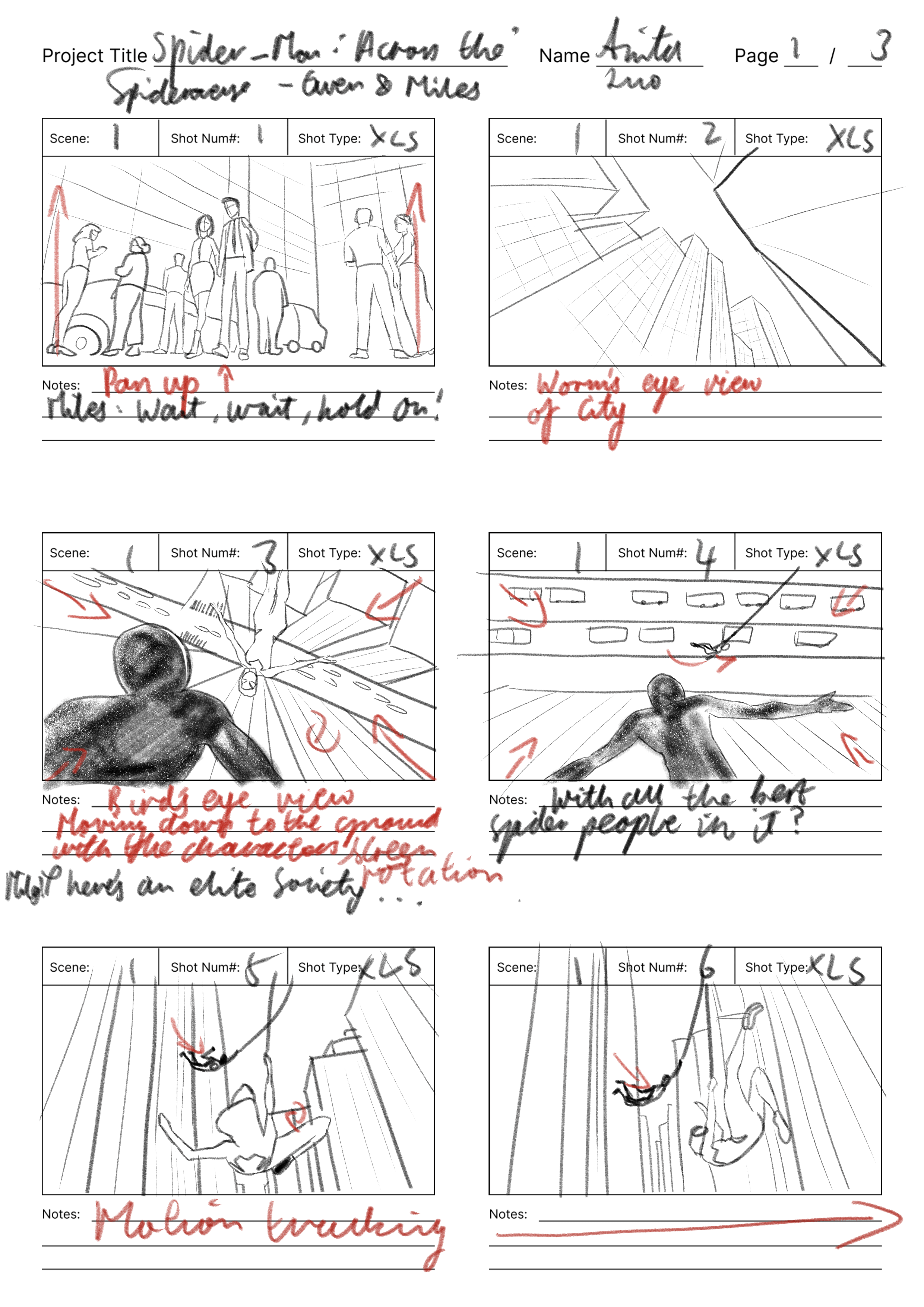
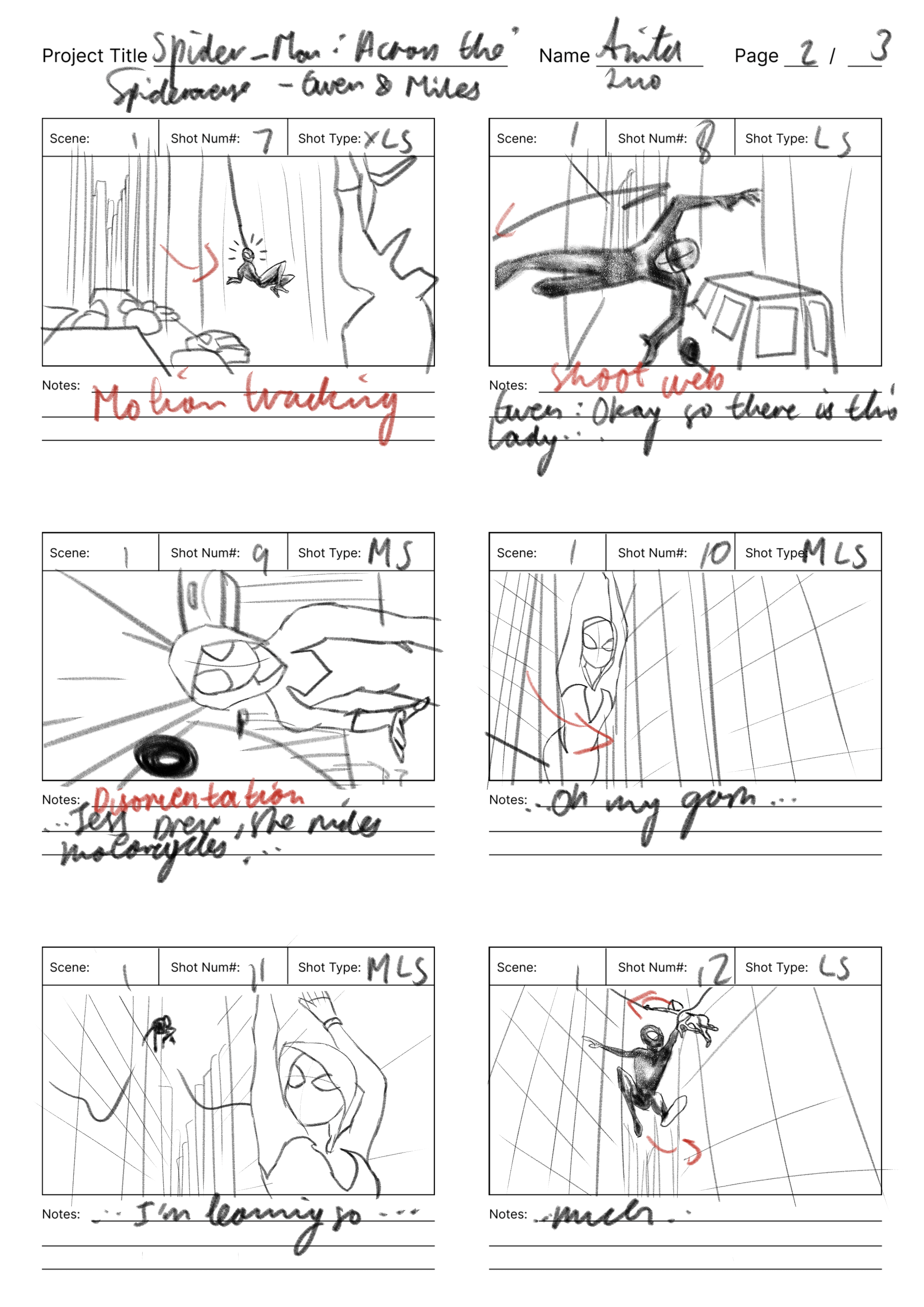
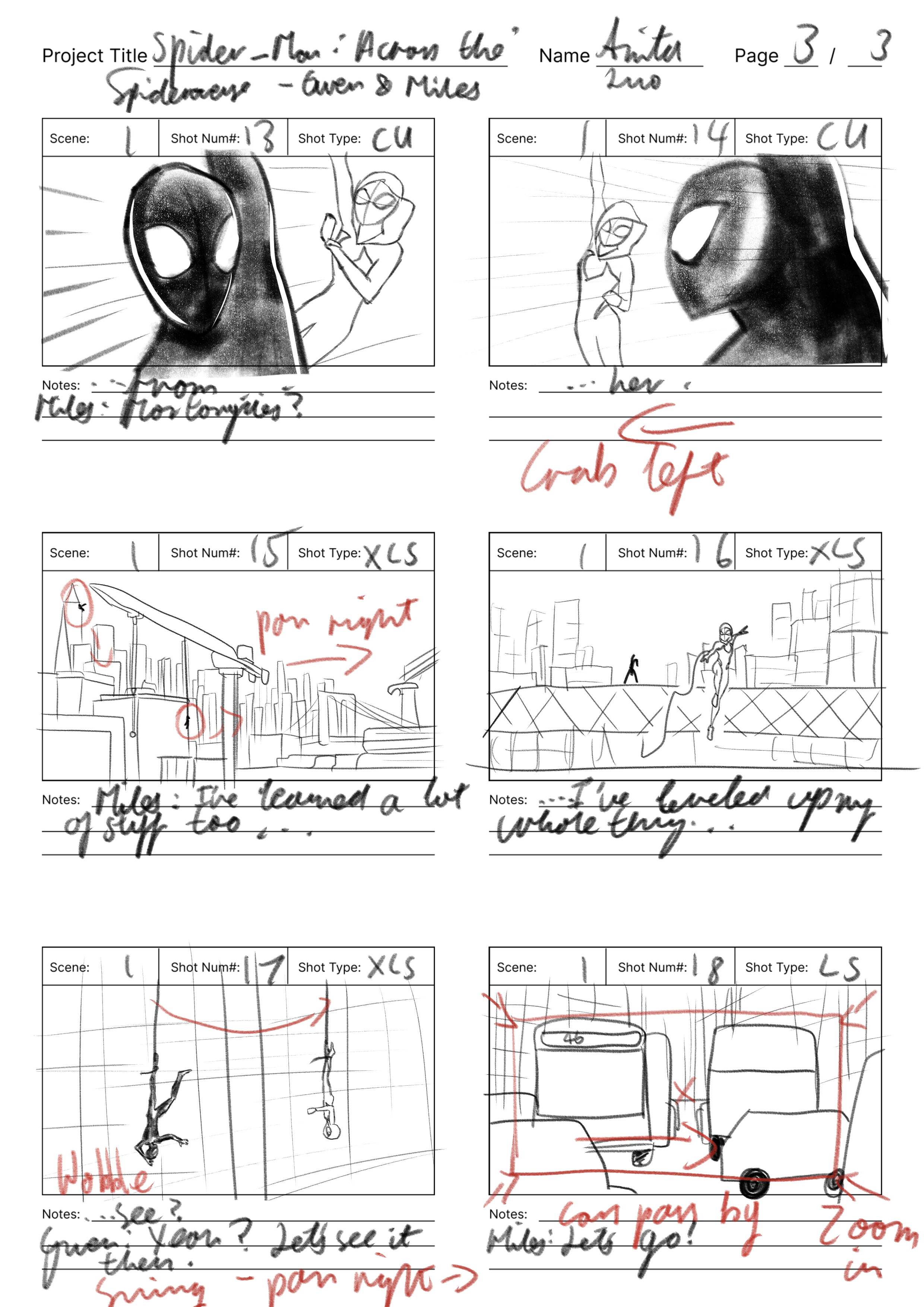
Introduction
I was assigned to create a storyboard from “a section of a movie (no trailer or remixes), a TV ad, or a music video.” I intend to utilize this storyboard exercise to consider how film sequences can be broken down into panels—from an intricate and sizeable scene to smaller components—and how this can inform me about the filmmaking process.
Concept/Choice Explanation
For this exercise I chose a scene from Spider-Man: Across the Spider-Verse. The film has been widely commended for its ingenious cinematography and film techniques—creating a visually captivating and dynamic experience. The use of comic book-like visual effects, framing techniques, editing techniques, and use of split screens adds depth and excitement to the storytelling. I chose this scene to expose myself to these various aspects to learn more about different techniques and skills to ensure that I am well-equipped for the final project. Existing films such as Spider-Man can also be a source of inspiration for my final project. Learning from others is a good skill to harness.
Process
While drawing out the storyboard I considered the scene number, camera angle, movement, shot, description, and lines of dialogue. I used Clip Studio Paint to draw the storyboard.
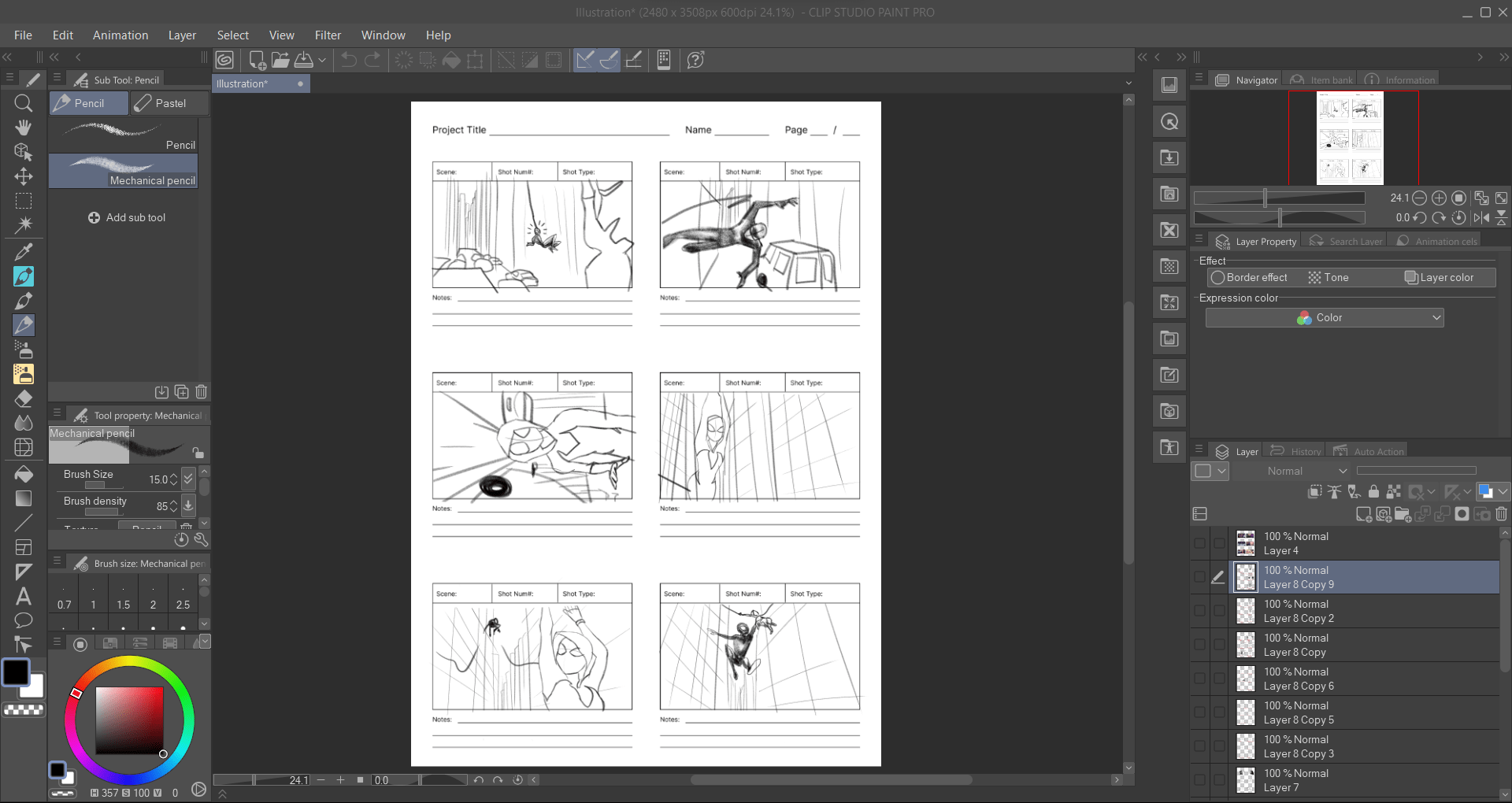
Conclusion
By reverse storyboarding, we can gain insights into the underlying structure, pacing, and visual filming techniques employed in a scene such as the composition and framing choices made, how different shots and angles contribute to the overall storytelling, and how these overlapping elements convey the intended message and mood. On the other hand, the exercise reveals how storyboards act as a visual blueprint during the filmmaking process: they refine the creative vision of the film so that the final product is cohesive and compelling. It ensures that everyone involved in the production is on the same page during communication and collaboration and working towards a common vision. Furthermore, storyboards allow filmmakers to anticipate potential challenges or limitations in the execution of certain shots or sequences. Additionally, it’s an opportunity for problem-solving and adaptations before committing to resources. The use of storyboarding can be seen in The Five Obstructions in which we see Leth planning out his ideas. Thus, this exercise exposed me to a variety of film techniques, taught me how to refine my communication of these techniques, and appreciate the significance of the step of storyboarding.
Everyday Activity
Introduction
I was assigned to create a 30-second instructional video of an everyday activity. Through this exercise, I intend to explore different camera angles and movements that we learned in class, consider the structure of the video, and further familiarize myself with filming equipment. The assignment also encourages us to consider various audio/sound options to assist the narrative in the video.
Concept
In this video, I wanted to capture one of the more special daily activities I had in South Africa—making honey lemon ginger syrup. I wanted to illustrate the warm and innocent memories of picking lemons, washing them, and chopping them by creating a fresh, simplistic, well-lit, and sound-sensitive film. The attention to detail was intentional to produce a raw—like raw lemons—and wholesome video. I tried using different shot types, movements, and creative ways to transition such as zooming in and out, diagonal lines, and spinning through the editing phase. Furthermore, a lot of the shots are noticeably close-ups because I wanted to produce a sense of intimacy and immersion. Thus, my video lies in its ability to provide relaxation, immersion, and a sensory experience that can be both comforting and enjoyable for the viewers—this is a result of the collaboration of sight and sound.
Inspiration
My video is inspired by the multitude of cooking ASMR videos on YouTube in which they pay particular attention to sound. There are a lot of soft sounds and gentle movements—these are particularly interesting to take notice of in the final project. The sounds and visuals associated with cooking, such as the crackling of a frying pan or the aroma of freshly baked goods, can evoke memories and create a sense of comfort and familiarity. Cooking ASMR videos often feature soothing sounds, such as chopping, sizzling, and stirring, which can create a relaxing and calming effect for viewers. Furthermore, these types of videos provide a vicarious experience—the close-up shots and attention to detail in these videos can make viewers feel like they are right there in the kitchen which enhances the overall appeal.
Process
Step 1: Pre-Filming
This step involves planning and preparation before the actual filming begins. I created a brief storyboard, selected a location, and found a time suitable for lighting.
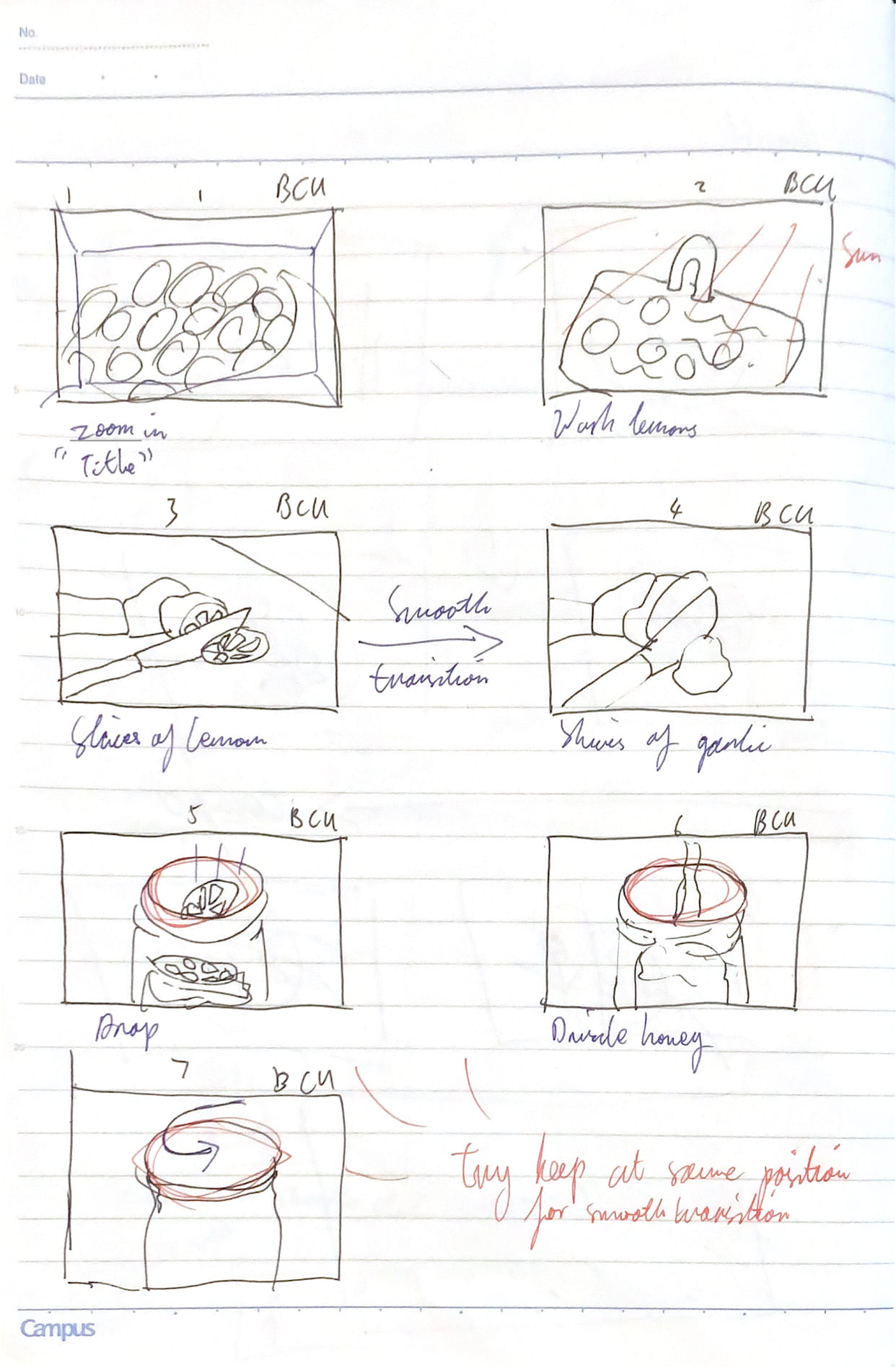
Step 2: Set-up
On the day of filming, I had set up the equipment. I shot the video using an iPhone XS Max—I ensured to select the 4k resolution on my phone—and a tripod. My choice of equipment is due to the fact that I was handling food so I wanted to prevent any damage to the equipment borrowed from the campus. I also prepared the set by placing the cutting board, lemon, ginger, honey, and jar on the counter.
Step 3: Camera and sound checks
I ensured the proper functioning and quality of the cellphone’s camera and sound by filming a video first. I also checked framing, focus, and lighting to capture the scene effectively.
Step 4: Filming
During filming, I paid particular attention to the natural lighting cast by the sun because I wanted to deliver a sense of warmth and freshness. I made a few adjustments to what was presented in the storyboard because the position of the subject matter had to be adjusted for the perfect lighting and sometimes the subject was obscured from certain positions.
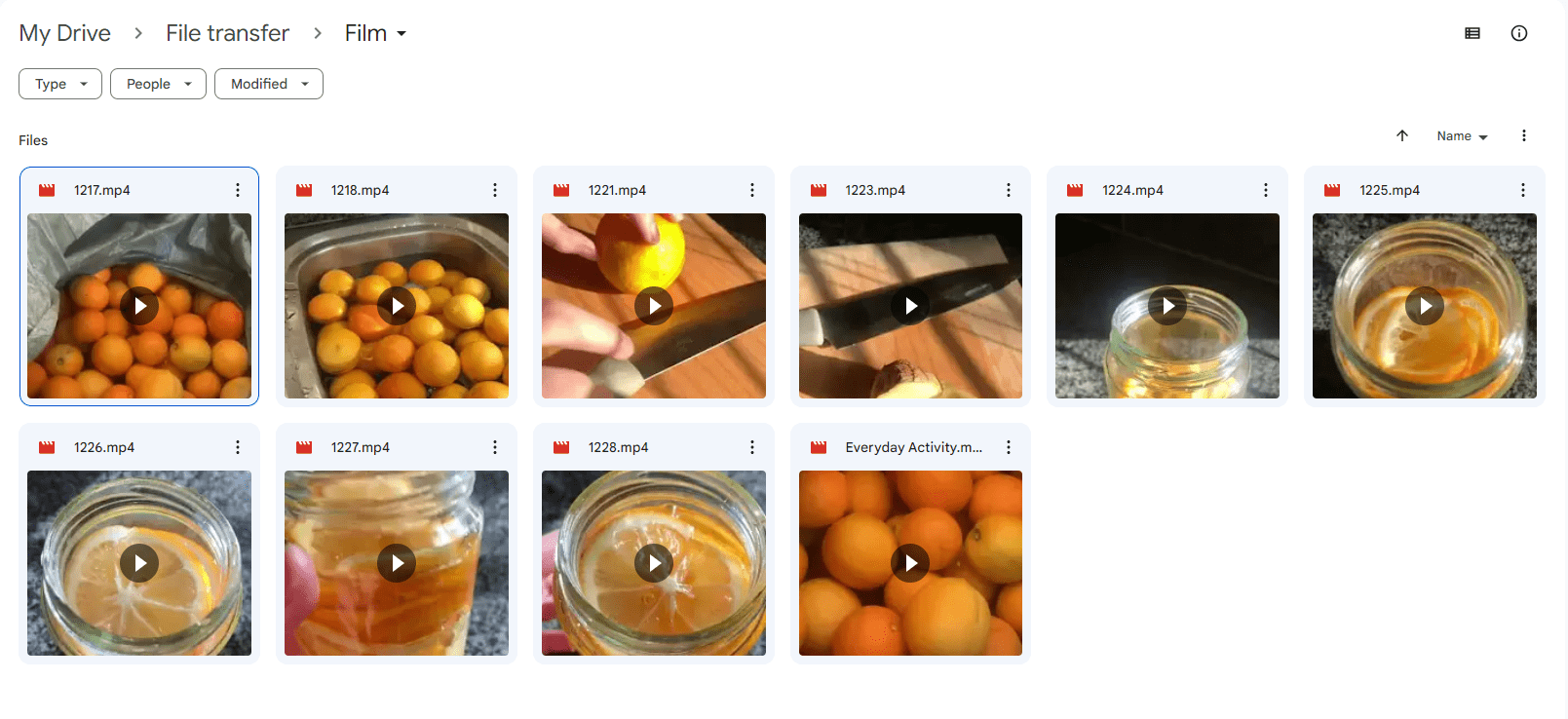
Step 5: Editing on Adobe Premiere Pro
I picked 5-10 seconds of each shot taken that met the standards of good lighting, resolution, and sound. After I had done so I compiled all the shots together. I utilized “warp stabilizer” for the shots that had noticeable shaking. I also paid particular attention to the smooth transitions between shots by ensuring that movements and objects lined up by adjusting “positions”—this can be seen in the transition between the lemon and garlic.
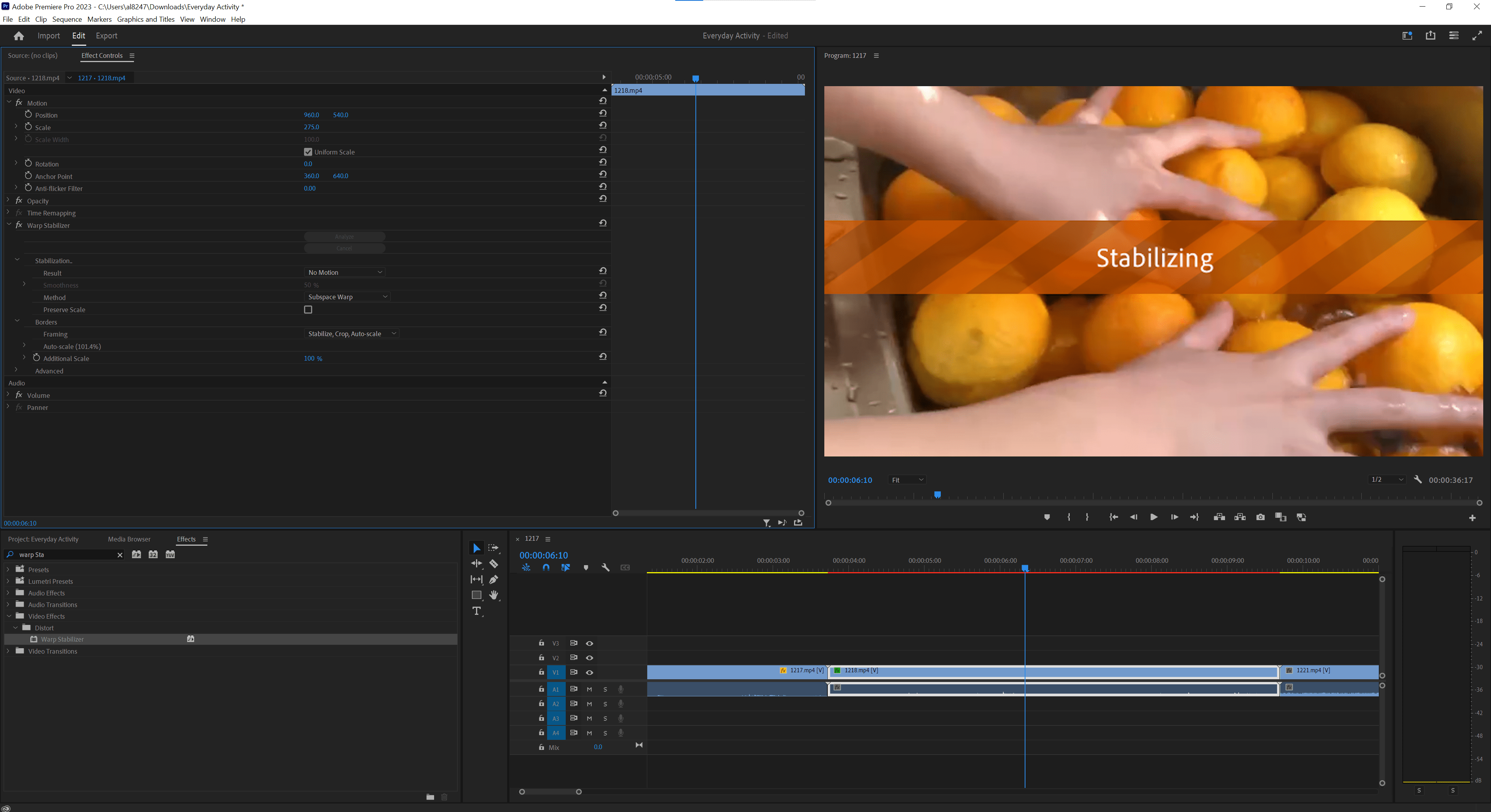
Step 6: Editing on VideoLeap
Due to time and also the fact that I didn’t know how to add text, I decided to use an editing application that I was more familiar with for text and transitions. I decided to use white text because of its simplicity which could enhance the softness of the video. I experimented with different types of transitions in VideoLeap which also prompted me to steer away from the original storyboard. For example, the swirl transition at the end was not within my vision but it was a great addition to the video which added movements and creativity to it.
For the final project, I intend to use the text function on Adobe Premiere Pro.
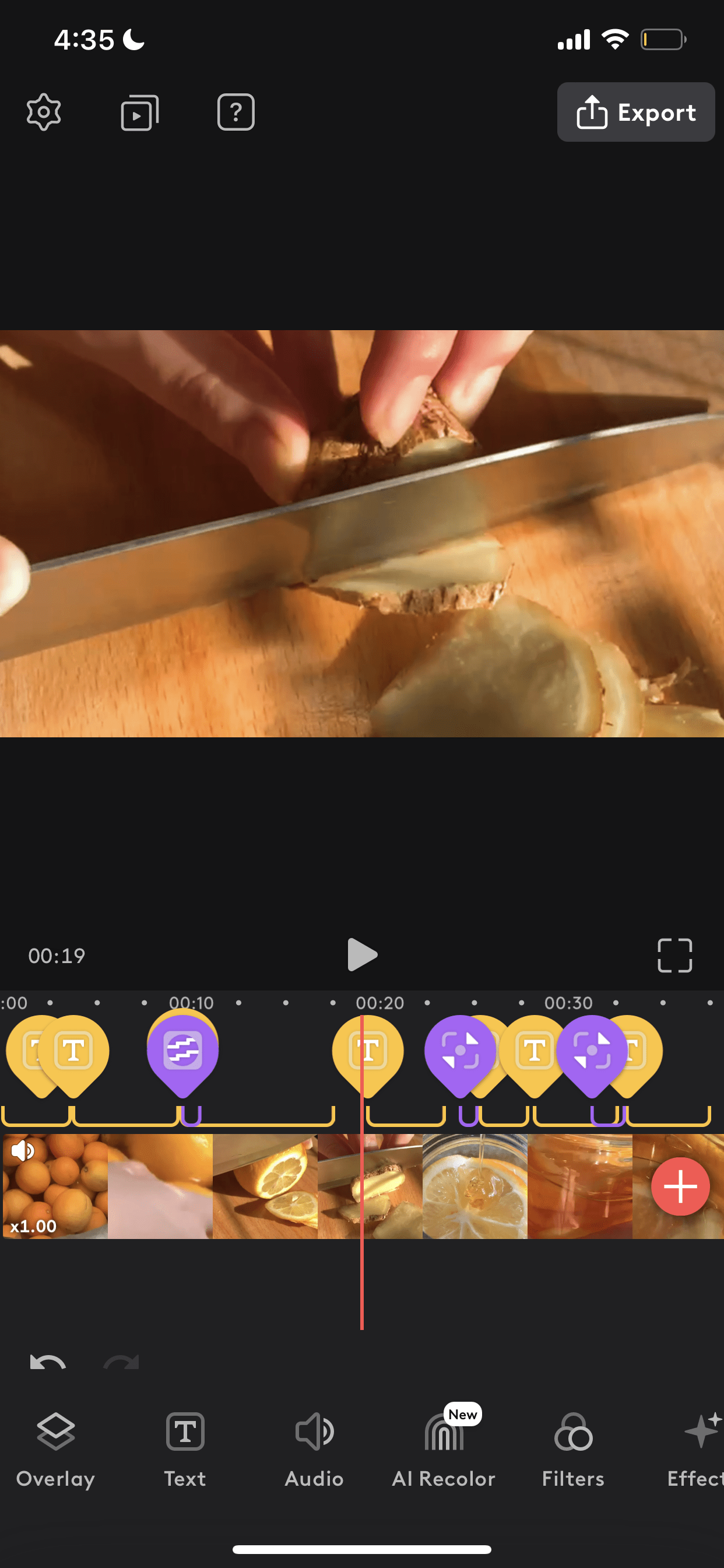
Step 7: Final Adjustments
After reviewing the video I found a transition that looked out of place where it zooms in on the garlic so I removed the feature. Secondly, I added credits for the editing software that I used at the end of the video instead of the beginning.
The video above is the old version.
Adaptation Mapping and Reflection
- I had to adapt to unpredictable weather conditions. Thus, I had to check for the most favorable weather conditions to film the video. Furthermore, I had to adjust a few angles and positions from the storyboard to ensure that I had the best lighting.
- Due to time constraints, I resorted to using another application. Sometimes due to unforeseen circumstances, one can find alternatives. However, if I have time I would like to learn and familiarize myself with Adobe Premier Pro instead of using VideoLeap as VideoLeap is a phone application and has limited functions. Furthermore, the continuous transfer of files from one application to another has most likely reduced the resolution of the final video. Thus, for the final project, I will aim to only use one application preferably Adobe Premiere Pro.
- Because I was filming myself I did not realize that I had recorded some shaky videos such as the shot of washing the lemons. Thus, through the editing phase, I fixed a lot of filming problems by stabilizing, denoising, and zooming in and out.
- One downside to my video was the gentle humming from the stove which I did not notice at the time of filming. Not only is sight important but sound is too. Thus, in the final project, I will pay more attention to the sounds that I record as the relationship between sight and sound is critical in the project.
- In this exercise, I had noticeably exercised agency during the filmmaking process. The advantage of creating a film without the traditional steps is mostly the flexibility and efficiency offered by modern technology. It’s important to note that while digital technology offers advantages, traditional film procedures still hold a lot of value due to their unique appeal and process.
Conclusion
This activity could be regarded as one with obstructions. The instructions were specific: the video had to be 30 seconds, it had to be an instructional video and had to contain different camera angles and movements. Through this exercise, I learned a lot about adaptation where unforeseen circumstances catalyzed my self-growth as an artist. I learned the art of trying new things such as the time I had to test different types of transitions and finding unexpected but good results from it. Furthermore, I have come to appreciate the intricate, extensive but very necessary steps of filmmaking such as planning, setting up, camera and sound checking, filming, editing, and reviewing. This activity has taught me technical skills, time management, problem-solving, attention to detail, visual communication, adaptability, and flexibility.
*Extra: AI Tools for Video Editing
Although I did not use AI in my work, it is interesting to investigate the accessibility of AI tools for video editing today, particularly VideoLeap. It is an easy-to-use video editor application that lets you transform and edit videos into professional-quality clips in only a few minutes by offering artistic effects, layer editing, premade templates, advanced features, and AI tools.
For example, VideoLeap offers AI Recolor and AI Image.
AI Recolor follows the prompt given to color the video.
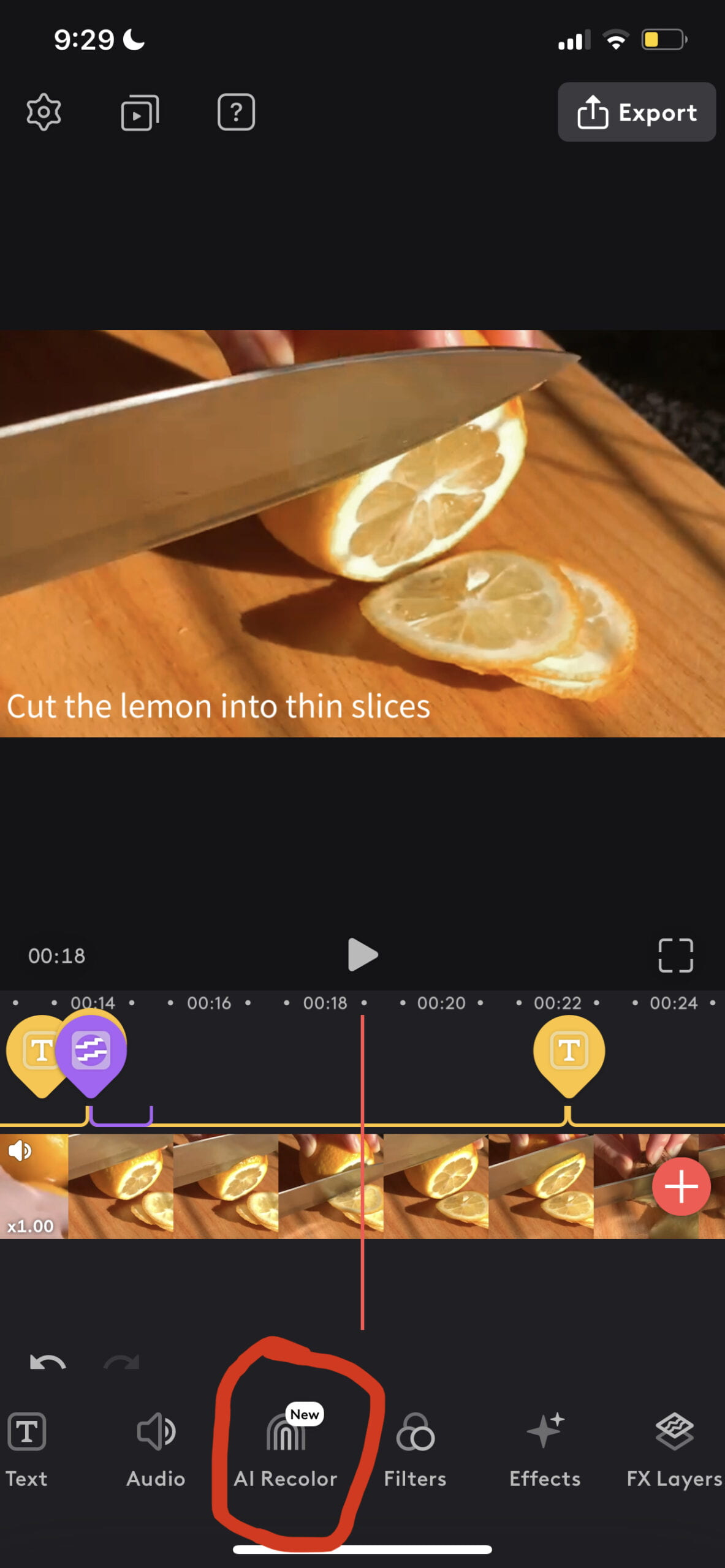
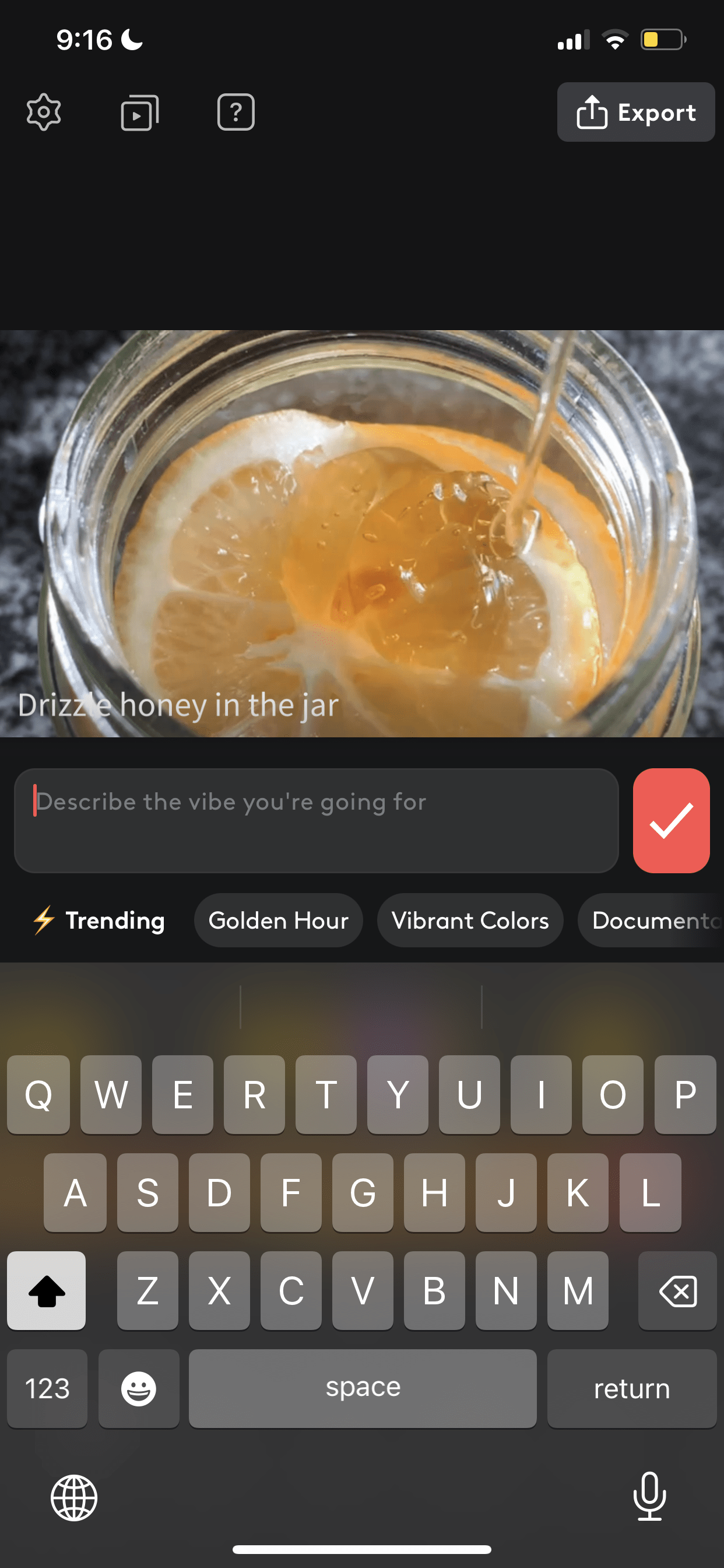
AI Image is similar to the image generators found online where you put in a prompt and select a style. These images can be directly used in VideoLeap. This feature also makes me curious about whether there are AI video generators, not video editors but actually creating moving images, that exist already or not.
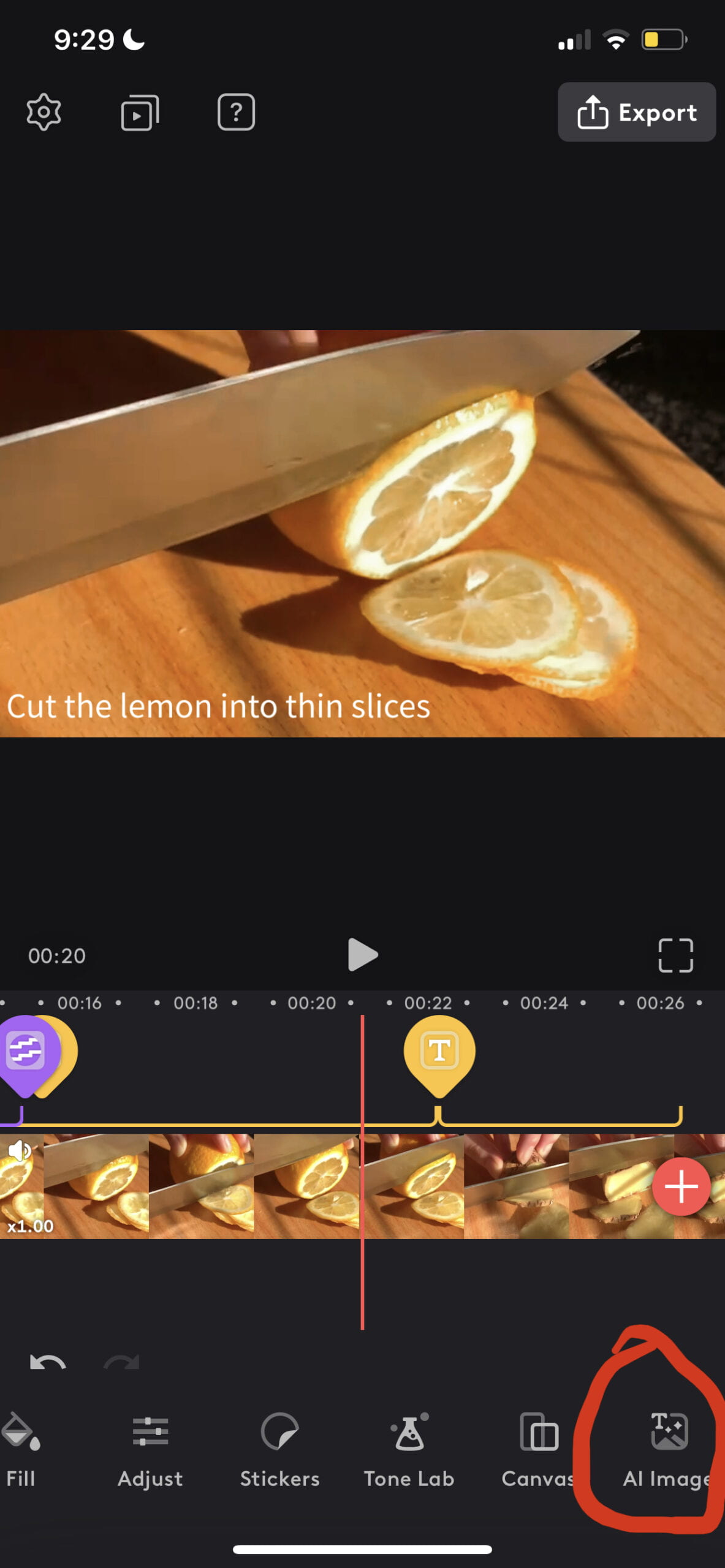
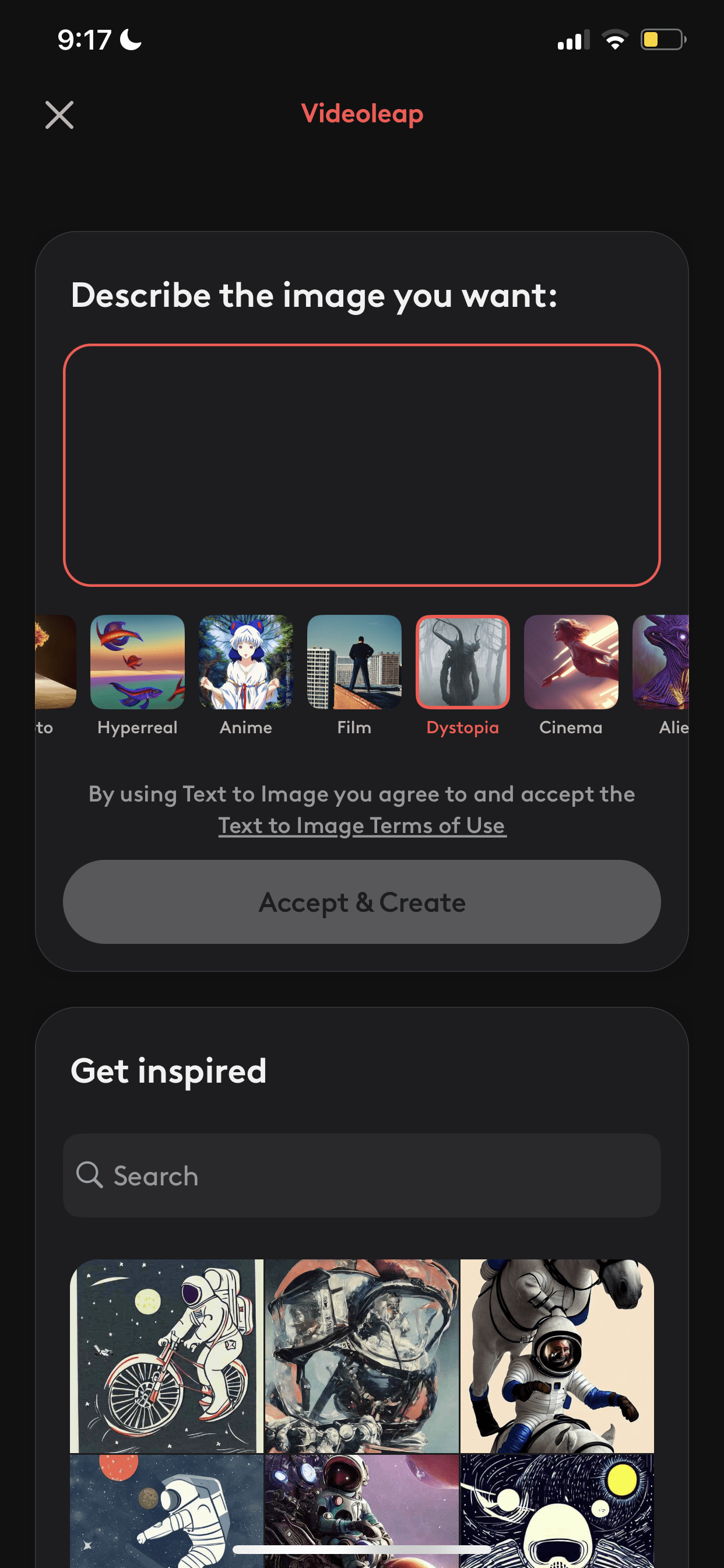
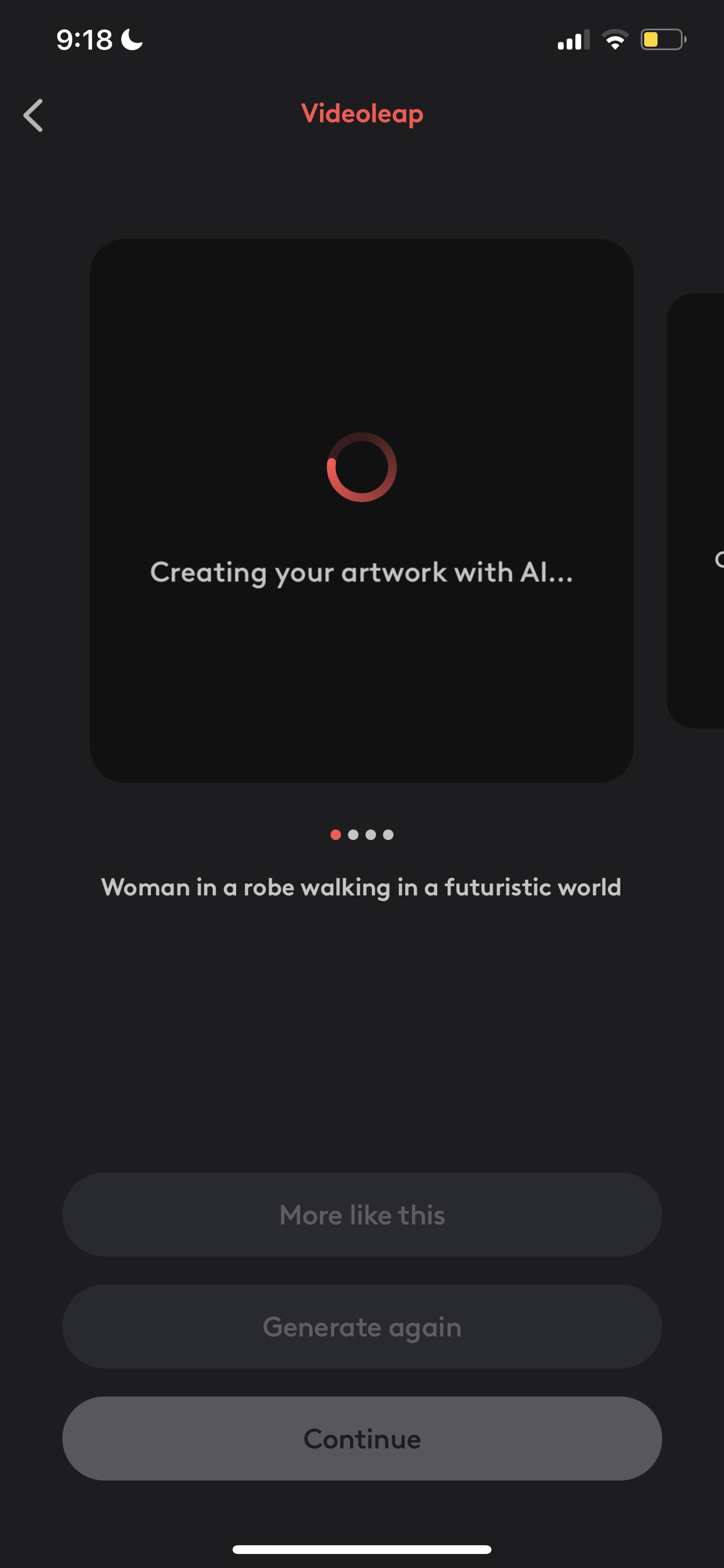
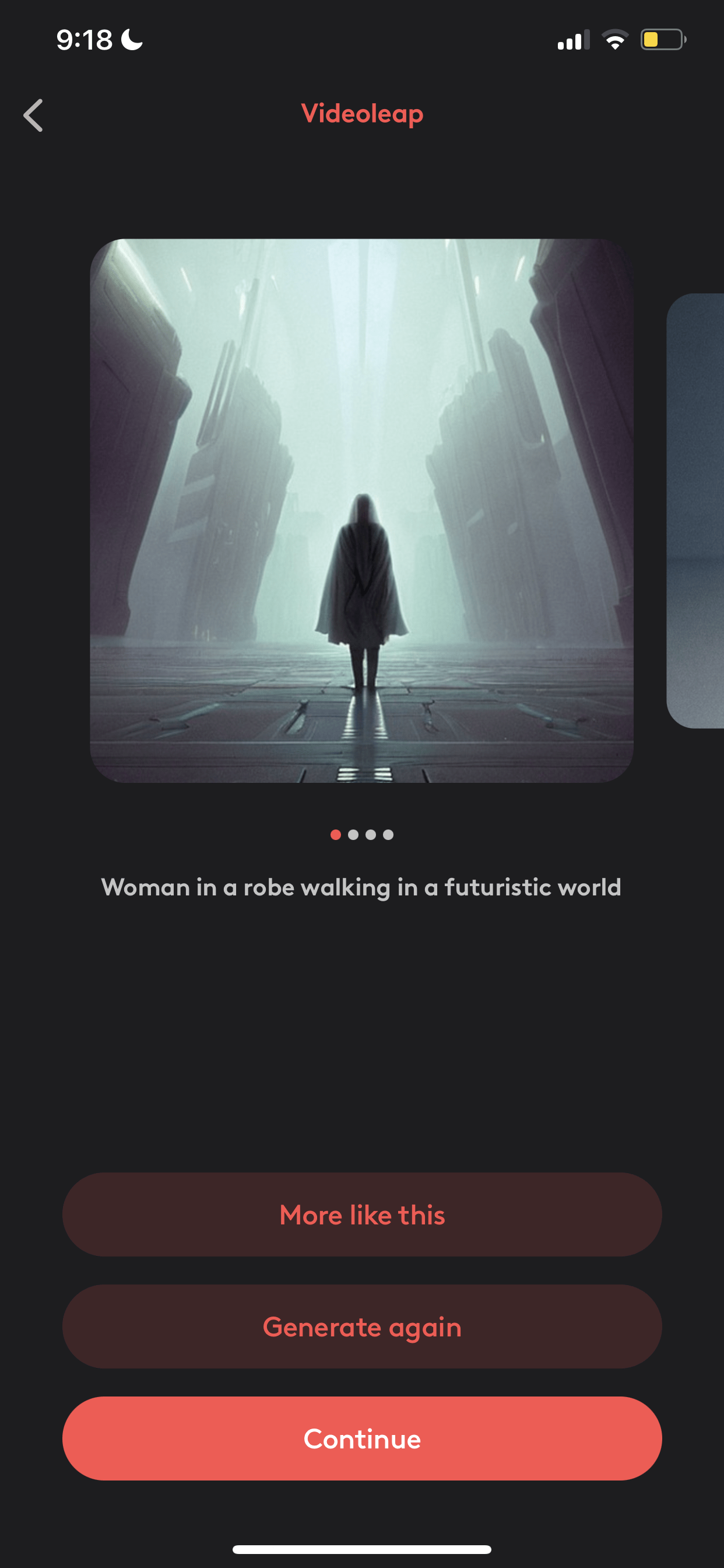
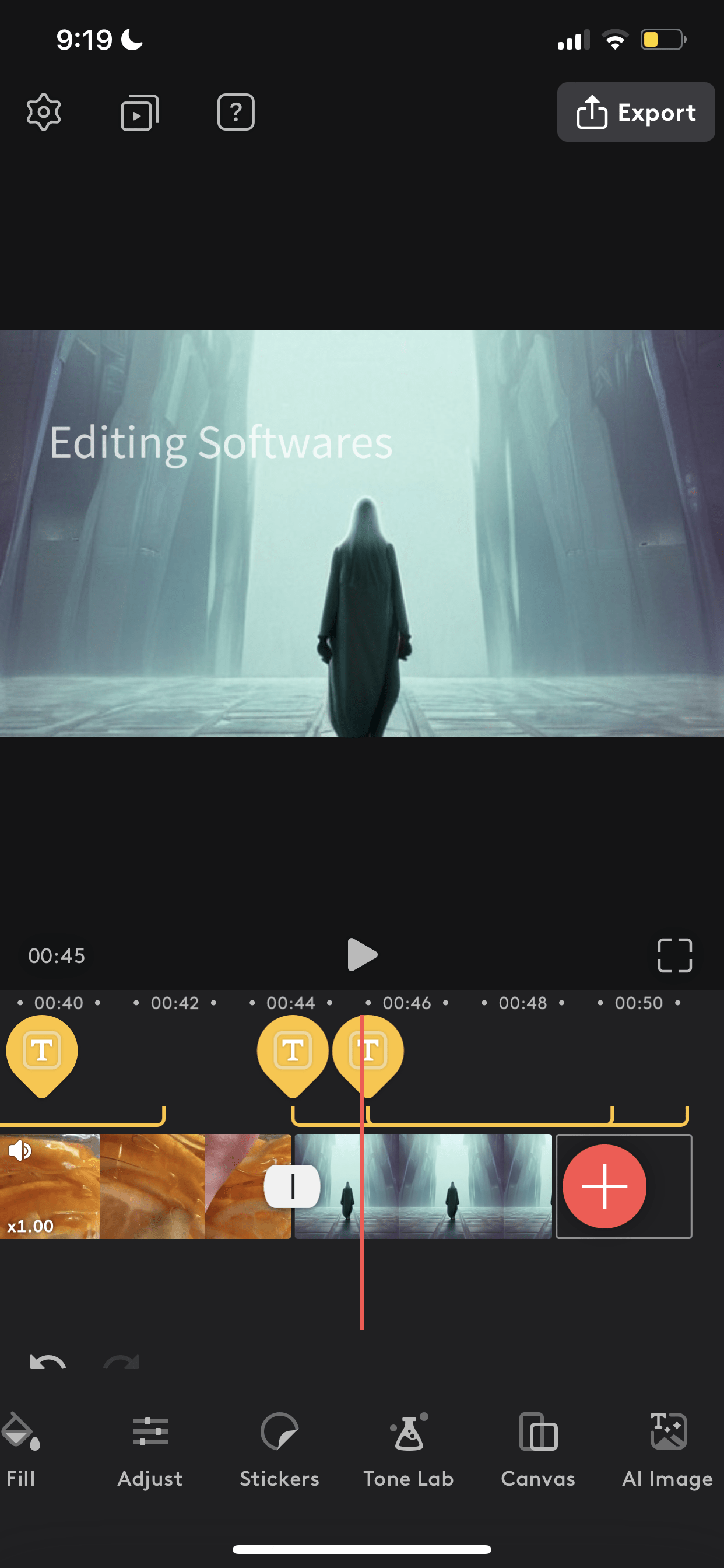
However, some AI tools in Videoleap require a subscription to be used in projects.
From this example, you can see how accessible and easy it is to use AI for video editing today—you only need a cellphone.
Sources to check out if interested:
Juxtaposition
For better viewing: 1BBD7749-BC46-4EF8-9C60-2334092A5D91
Introduction
I was assigned to create a 30-second to 1-minute split-screen in 1920*1080 HD video where two scenes are in conversation/connection with each other and can be non-narrative. Through this exercise, I intend to explore the concept of a visual metaphor and focus on how the elements of film can evoke vivid emotions. I also wanted to see how sound could relate to sight.
Inspiration
I was inspired by Kontakt 2020, a film by Rosa Luckow, that uses juxtaposition to create conversation and a relationship between two moving images side by side.
Concept
In this video, I wanted to portray a sense of delicate and frantic energy that offers spikes of hysteria while also a fresh perspective on our surroundings. Thus, there is the theme of the power of nature, its fragility, and its simultaneous impending force. My choice of music was Sonata by Ryuichi Sakamoto. Sakamoto combines contemporary, percussion-heavy synth sounds that sound metallic and dreary with fast, classical runs of notes. It’s an exhilarating juxtaposition that exemplifies Sakamoto’s ability to take simple elements and turn them into something special. Even with its little orchestration, Sakamoto crafts an amazing cinematic soundscape out of it. Its tripled tempo causes the overlapping sounds to become dissonant and unstable. Similarly, the video above feels unstable and discordant while the images on the left compliment the right.
Progress
Step 1: (Pre-)Filming
Instead of following the traditional steps of filming, I followed the steps in the reverse order in that I started with filming. The inspiration for filming this video was spontaneous. I was at Yuyuan one day and noticed how unique the waters rippled in the pond. Similarly, later that week I noticed how the shadows cast by the trees had a similar “dance” to it like the water in the pond. Thus, I wanted to connect their relationship and how the components of nature have almost a shared bond and shared energy. Thus I picked out more videos from the Yuyuan trip for this exercise.
Step 2: Editing
Unfortunately, students occupied all of the computers on campus and I did not have Adobe Premiere Pro on my personal laptop. Thus, I utilized VideoLeap once again to create the juxtaposition. Fortunately, the editing was not complicated so there were no limitations or obstacles during the editing phase. Furthermore, I experimented with filters to create a more vibrant shot for the lemon part. Additionally, I experimented with speed and reverse so that I could find a way to match the sound and sight to create a rhythm-sensitive video. Instead of using this exercise to familiarize myself with Adobe Premiere Pro, I took this chance to experiment with different filters, orientations, speeds, and other features that could spark any ideas for the final project. For the final project, I intend to experiment with these features on Adobe Premiere Pro.
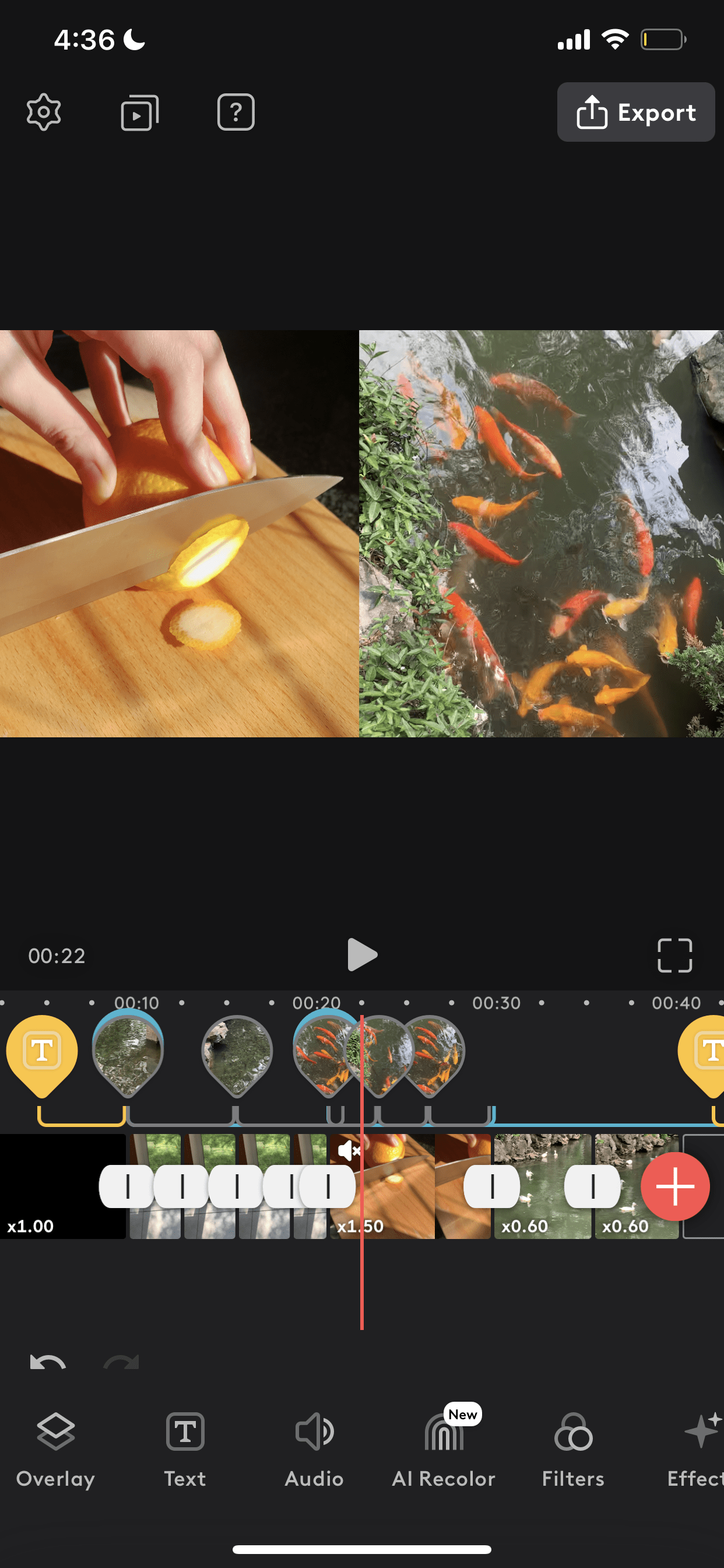
Step 3: Music and Vision
To solidify my concept, I chose Sonata by Ryuichi Sakamoto as my background music. As explained in the “Concept” section, Sakamoto combines contemporary, percussion-heavy synth sounds that sound metallic and dreary with fast, classical runs of notes. It supports the idea that the power of nature is through a sense of instability and frenzy.
Adaptation Mapping and Reflection
In this exercise, I had noticeably exercised agency during the filmmaking process. The advantage of creating a film without the traditional steps is mostly the flexibility and efficiency offered by modern technology. It’s important to note that while digital technology offers advantages, traditional film procedures still hold a lot of value due to their unique appeal and process. Thus, the choice between traditional and digital methods depends on the artistic vision and pragmatic considerations of the filmmaker. However, I do believe that for this particular incoming project, the traditional method would be more advantageous as it ensures quality. This exercise can be considered a fun experiment and an opportunity for me to exercise freedom.
Conclusion
Through this exercise, I found that using color, shape, size, motif, and sound, can enhance the metaphorical impact of juxtaposing images in conversation with each other. Visual metaphors can be subtle and involve using imagery to represent an abstract concept or idea. In order to create connections between the visuals and the elements of the concept, we need to consider how the visuals can symbolize or represent the abstract concept in a meaningful way, and explore different ways to arrange the images to create a compelling composition. Furthermore, experimentation is key to finding the most impactful and meaningful ways of communication.
If I have time, I would like to revisit this exercise and make improvements.
Rationale
It is true, according to Steyerl, that films can “create false intimacy and even false presence.” This is evident in the way in which I planned, prepared, and carried out my filmmaking exercises. Everything had an aim and every element had to “fit” into a certain concept which limited the scope of reality. However, one must admit that the purpose isn’t false. In other words, the efforts and thoughts put into these expressions or representations, whether synthesized or not, aim to appeal to the audience and deliver a certain message. The filmmaking process, as we have seen above, is scrutinous and extensive, and in order to create the most compelling message one needs to forge an intimacy and presence. On the other hand, the struggles and obstacles that the filmmakers face are very real and I think that this is a very meaningful experience for me. As viewers, we have the responsibility of judging a film critically and evaluating its significance whether it lies in its truths or falsity. Either way, there is always something to learn from the experience of watching listening, and even making films. I hope that the final project will allow me to embrace how fiction—visual metaphors—can inform the truth and create a compelling piece of work.